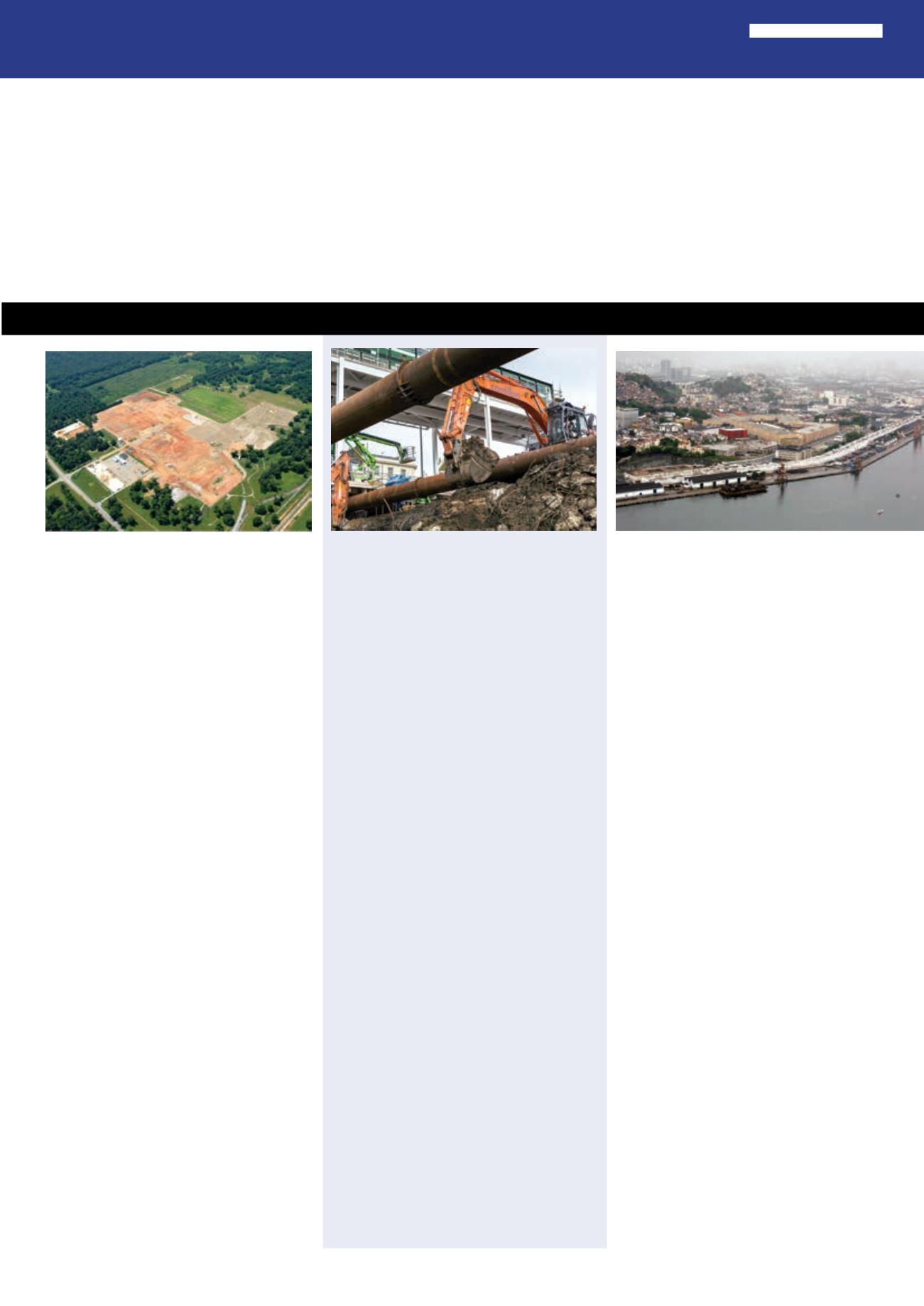
WORLD
DEMOLITION
AWARDS
2O14
31
d
&
ri
DEMOLITION AWARDS SUPPLEMENT 2014
This special
D&Ri
supplement features the shortlisted entries for this year’sWorld DemolitionAwards. Entries were
received from around theworld for the various categories up for grabs,meaning that theAwards truly represent the very
best the global demolition industry has to offer. Here entries that have been shortlisted for the various Award categories
are detailed in alphabetical order
CELEBRATING THEBEST
Brandenburg Industrial ServiceCo.
Merck Flint River Plant,
Albany,Georgia
Brandenburgwas contracted to perform the
demolition, environmental remediation, and asbestos
abatement of the 65,000m
2
(700,000 ft
2
) former
Merck Flint River Plant located in Albany, Georgia.
The 100 acre site contained over 115,000 tons of
contaminated concrete, blocking and asphalt that
was transported to local landfills using a large fleet
of trucks and Brandenburg’s custom engineered
demolition trailers. All had to be properly permitted
and licensed to haul specificwaste streams. Five
hundred tons of hazardousmaterial was delivered to
an incinerator in Texas and 5,000 tons of hazardous
material concretewas required to bemoved to Emelle,
Alabamawhere it was landfilled.
Once abatement was completed, structureswere
dismantled following optimal methods to segregate
thematerials. This phase included several multiple
story buildings, housing elevator shafts 15.3m (50
ft) below ground, pipe racks, tank farms, offices, and
all underground utilities, foundations and basements.
Therewere 1,322 loads of scrap that generated
14,900 tons of recyclablematerial. Excavations of
several 1.8m (6 ft) thick foundationsmore than 9m
(30 ft) deepwere removed.
Throughout daily operations Brandenburg
maintained a focused crew of 30-40 trained
employees and used its fleet of specialised heavy
equipment, including eight Liehberr 954 excavators,
a Liehberr 924, a KomatsuWA500 loader, a Cat 973
track loader, numerous skid steer loaders and 15-20
trucks all operating simultaneously. The final stage
was backfilling all excavations caused by the concrete
removal.
The project was completedwithmore than
125,000man hoursworkedwith zero lost time
accidents and demonstrated environmental
conservation, community improvement to health and
safety, and a positive impact on the quality of life.
Brandenburg enhanced the site for future development
and a safe environment for the community.
CONTRACTOF THEYEAR
OVERUS$1.5MILLION
Cantillon Ltd
100CityRoad, London, UK
Cantillon has been shortlisted for the demolition
work it carried out as part of a redevelopment project
100City Road in London, UK. The largest building,
the 9 storey TransworldHouse, was located on City
Road alongside the smaller 6 storey Featherstone
House 1 and 6 storey SophiaHouse. AlongOld
Street, CommunicationHouse at 3 storeys, and
the 4 storey Featherstone House 2were located on
Featherstone Street. The sitewas a large island in a
cluster with amarketing suite for sales for the follow-
on stage located on City Road, constructed on a
metal framework connected via a raisedwalkway to
CommunicationHouse that was open to the public
during the initial stage on sitewhile asbestos removal
and soft strip took place. Themarketing suitewas then
demolished later in the duration of the project.
At tender stage the client had approached Cantillon
with a demolitionmethodology plan that included
an external steel framework supporting building 3
(Featherstone House 1) and building 5 (Featherstone
House 2) with footings to sit over the area due to
be excavated. Thiswould hinder the timetable for
completion and incur a high cost to the overall project.
The Cantillon team developed an alternative
methodology that allowed the client to see a new
approach to the demolition phase that used an internal
bracing systemwithin the buildings as opposed to
using the steel frame suggested by the client. Prior to
demolition on building 3 the internal bracing system
was implemented.
Demolition commenced on one building at a time,
using a high reach excavator located in themiddle
of the site and continuedwith 30 tonne excavators
once down to level two. This continued down to and
including ground level slabswhile retaining parts of
Featherstone House 1&2.
Due to the high volume of foot traffic aswell
as two entrance ramps toOld Street tube station,
gantry protectionwas in place prior to demolition of
cantilevered slab of 100City Road.
FabioBrunoConstruções Ltda
Perimetral Viaduct,
Riode Janeiro, Brazil
Fabio Bruno Construções has been shortlisted for
the Perimetral Bridge demolition in Rio de Janeiro for
client Consórcio Porto Rio. To successfully carry out
thework, a number of challenges had to overcome.
The demolition had to be carried out in a densely
populated area in themost central region of the city of
Rio de Janeirowith several protected buildings owned
by the BrazilianNavy located around and below the
bridge structure. At least 95% of all steel beams had
to remain intact during the process of implosion or
demolition.
The first implosion of a 1,200m (3,940 ft)
steel and reinforced steel viaduct was performed to
minimise impact on traffic, with all preparation for
the implosionmadewith traffic flowing. After this
implosion, sevenmonthswere available to complete
the demolition stretching 5.000m (16,400 ft).
A second implosion of a huge post tensioned 300
m (985 ft) concrete viaduct was necessary because
theWorld Cupwas nearing and the port was located
exactly in front of the structure. The street that passed
under the viaduct is one of themost important routes
out of downtown and Fabio Bruno had only three days
after the implosion to clear part of the road and keep
traffic flowing, and 20 days to clean the entire area.
Protection of all the pipes and cables located
below the entire viaduct was required. Some had
been in a placemore than 80 years and therewas
no specific drawings for these pipes. In addition, no
debris could be allowed to fall from the viaduct into the
adjacent ocean in some specific areas.
More than 40 different demolition scenarios
were simulated to achieve the strict project goals
set out by the customer, ensuring steel beams
survived undamaged, surrounding structureswere
not damaged, and that maximum ground vibrations
did not damage tunnels and underground pipes.
Four different methodologies of demolitionwere
also developed and utilised to guarantee the best
demolition process along the length of the viaduct.


